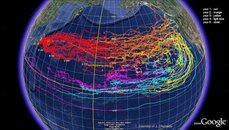Microwave ovens do not produce ionizing radiation which causes molecular bond breaking and chemical disruption; they only cause resonant vibration of water molecules leading to heating.
The dose in certain regions downwind of the plants at the time of the accident is still a bit high; you can see some good maps
here. If you were to be in one of the "hot" regions with 20 microSieverts/hour dose rate, in a year you would get a total dose of 175 milliSieverts (mSv). On the one hand this is far below the 5000 mSv dose needed to kill half of those exposed; you would only slightly increase your statistical chance of dying from cancer. On the other hand this is far above the 3 mSv background dose that we all get from living on a planet with natural radioactivity in rocks (and radon gas from soils), and cosmic rays from the sun and other stars.
So we should not worry about Fukushima radiation in Hawaii. Most of Japan is also just fine. However, we should not say that in the Fukushima region there is less risk than from microwave ovens.




